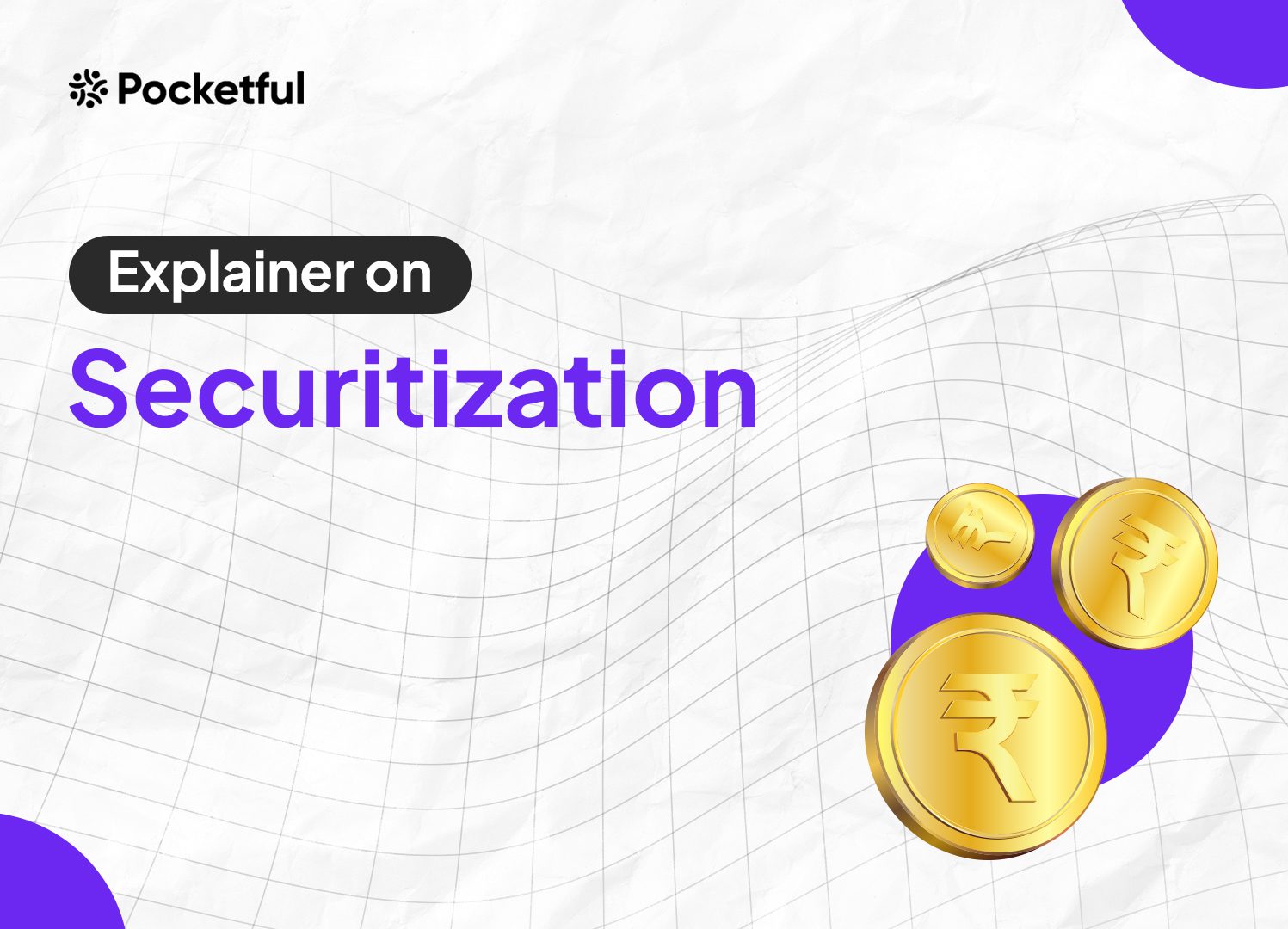| Type | Description | Contributor | Date |
|---|---|---|---|
| Post created | Pocketful Team | Apr-22-24 | |
| internal linking | Nisha | Feb-15-25 |

- Blog
- what is securitization methodology types advantages and disadvantages
What is Securitization? Methodology, Types, Advantages, and Disadvantages

Ever thought about how a car loan can be turned into an investment? Securitization makes it possible for you! This financial process turns loans into tradable securities and offers various opportunities with risks.
In today’s blog, we will explore the merits, demerits, techniques, and process of securitization.
What is Securitization?
In securitization, financial institutions bundle a group of loans or other income-generating assets together and transform them into a security that investors can trade.
Imagine a bank with a ton of issued car loans. Securitization allows the bank to sell these loans as a bundled security to investors. Investors then earn a return on their investment depending on the interest and principal payments made on the underlying car loans.

How Does Securitization Work?
Origination
Banks or other institutions originate loans, such as mortgages, car loans, or student loans. These are assets that will be securitized and serve as underlying collateral for the securities to be created.
Pooling
Financial institutions group similar loans together into a pool. This diversification spreads the risk in case some borrowers default.
Transfer of Assets to Special Purpose Vehicle (SPV)
The selected assets are transferred to a separate legal entity known as a Special Purpose Vehicle (SPV) or Special Purpose Entity (SPE).
The SPV is generally a bankruptcy-remote entity, which means that the financial health of the originating institution does not affect the assets held within the SPV.
Creation of Tranches
The SPV issues securities backed by the cash flows generated from the underlying assets. These securities are then categorized into different tranches, each with different levels of risk and return.
Tranches are the categorized portions of the overall pool of assets being securitized. They essentially represent different risk-return profiles for investors. Below-mentioned is a breakdown of tranches.
- Senior Tranches – these tranches have the highest credit ratings, such as AAA or AA, from agencies like CRISIL. This indicates a very low chance of failure. Additionally, senior tranches receive priority on the cash flow from the underlying asset. They receive interest and principal repayments from borrowers before any other tranche.
- Mezzanine Tranches – these tranches hold a middle ground regarding credit rating, such as A and BBB. They absorb some of the risks after senior tranches are paid. Investors in mezzanine tranches are partially protected in default situations because junior tranches are impacted first. Because of their increased risk profile, mezzanine tranches offer a higher return than senior tranches.
- Junior Tranches – these tranches have the lowest credit ratings, for example, BB, B, or even unrated. They represent the riskiest portion of the securitization. Junior tranche investors receive payouts only after senior and mezzanine tranches are paid in full. They offer the highest return on investment because of the highest risk borne.
Credit Enhancement
To attract investors, especially for lower-rated tranches, credit enhancement mechanisms may be employed to mitigate risks. These mechanisms can include over-collateralization or adding additional assets to the pool, cash reserves or third-party guarantees.
Issuance and Sale of securities
The securities, representing claims to the cash flows from the underlying assets, are then sold to investors in the capital markets. Investors buy these securities based on their desired risk-return profile.
Servicing
Servicing the underlying assets continues after securitization. A servicer, often the originating institution or a third-party specialist, is responsible for managing the assets on behalf of the investors and handling the day-to-day tasks of collecting principal and interest payments from the original borrowers. The collected funds are then distributed to the tranche holders as per the pre-defined structure. Senior tranches receive payments first, followed by the subordinate tranches.
Risk Management and Reporting of Securitization
Throughout the life of securitization, risk management practices are employed to monitor the performance of the underlying assets and ensure compliance with regulatory needs. Regular reporting to investors regarding the performance of the securities and underlying assets is also essential.
Types of Securitized Securities
Some common types of securitized securities include:
Asset-backed Securities (ABS)
This is a broad category that includes most securitized securities. A pool of underlying assets backs ABS, typically consisting of cash-generating assets like auto loans, credit card receivables, and student loans. Further sub-categorisation of ABS is possible based on the underlying assets.
- Mortgage-backed Securities – These are ABS-backed by pools of residential or commercial mortgage loans. Cash flows from the underlying mortgage payments are passed through MBS investors who receive interest and principal payouts.
- Auto Loan-Backed Securities – a pool of car loans backs these.
Collateralized Debt Obligations (CDOs)
CDO is a complex type of security that can bundle together different types of collateralized debt. This creates a layered structure with varying risk-return profiles.
Credit Linked Notes (CLNs)
These are structured debt securities that allow investors to gain exposure to credit risk linked with varied underlying assets such as corporate bonds, loans or other structured finance products.
Also Read: Collateral
Credit Enhancement Techniques
Two main categories of credit enhancement are listed below,
Internal credit enhancement
These techniques rely on features built into the structure of the securitization deal itself to improve creditworthiness.
- Overcollateralization – this involves structuring the deal so that the value of the assets backing the securities is greater than the total value of the securities issued. This excess collateral acts as a buffer in case of defaults, thus protecting senior tranches.
- Excess Spread – this refers to the difference between the interest earned on the underlying assets and the interest paid to investors on the securities. This excess cash flow can be used to cover shortfalls in principal or interest payments if some borrowers default.
- Subordination – The securitization structure is divided into multiple classes with varying payment priorities. Senior tranches receive principal and interest payments first, whereas junior tranches get payouts only after senior tranches are fully paid. This hierarchy absorbs losses from defaults.
- Cash Reserves – these are the funds set aside from the proceeds of the securitization to cover any shortfalls in cash flows from the underlying assets. These reserves provide a buffer to support payments to investors during periods of financial stress
External Credit Enhancement
These techniques involve bringing in external guarantees or insurance from third parties to increase the creditworthiness of the securitization.
- Letters of credit – Banks or other financial institutions can issue letters of credit assuring repayment of principal and interest on the securities in case of issuer default.
- Surety Bonds – insurance companies can act as sureties, guaranteeing to cover losses if there are defaults on the underlying assets.
- Third-party Guarantees – Guarantees can be provided by corporations or government entities, strengthening the creditworthiness of the securitization.
The choice of credit enhancement techniques depends on various factors, like the type of assets being securitized, the desired credit rating for different tranches, and the overall risk profile of the deal.

Advantages and Disadvantages of Securitization
Securitization offers various advantages and disadvantages to both financial institutions and investors.
Advantages
- Reduces Risk: It allows originators to transfer credit risk linked with the underlying assets to investors. This can improve their overall capital adequacy ratios, making them more attractive to lenders.
- Diversification: Securitization offers investors access to a wider range of investment opportunities. They can invest in tranches depending on their risk tolerance and desired return.
- Increased Liquidity: Securitised assets are generally tradable on the secondary market, offering investors greater liquidity compared to some traditional securities like private loans.
- Frees up capital: By selling off assets like loans, banks can free up capital on their balance sheets. This allows them to originate new loans, stimulating economic activity.
Disadvantages
Some significant drawbacks of securitization are as follows
- Complexity: The process of securitization can be complex and involves multiple parties, intricate legal structures, and complex risk assessments. This complexity can make it difficult for investors to understand the underlying assets and the risks involved fully.
- Transparency: In some cases, the underlying assets in securitization may need to be fully transparent. This can be because several loans from different borrowers are pooled, making it challenging to analyze the creditworthiness of each loan. This lack of transparency can lead to the mispricing of risk.
- Increased Costs: The securitization process involves multiple fees linked to legal structuring, credit rating agencies, and investment baking placement. These costs can ultimately reduce investors’ returns.
- Reduced Accountability: Securitisation involves numerous parties, making it difficult to identify accountability if something goes wrong, which can pose challenges in addressing problems.
- Systemic Risk: If a large number of borrowers default on the underlying loans in securitization, it can trigger a domino effect. The value of the securitized securities can fall, causing losses for investors. This happened in the 2008 global financial crisis when many mortgage-backed securities (MBS) went bad.
Conclusion
Securitization can be a complex financial tool that enables institutions to convert illiquid assets into tradable securities. It plays an important role in modern financial markets by facilitating the efficient allocation of capital, enabling risk transfer and providing investors with a diverse range of investment opportunities. As financial innovation continues, securitization is likely to remain an integral part of the global financial system, albeit with ongoing refinements and regulatory adaptations to address emerging challenges and promote market integrity.
Frequently Asked Questions (FAQs)
Who benefits from securitization?
Securitization benefits financial institutions by providing access to capital and reducing risk exposure. It also benefits investors by offering diversified investment opportunities.
How are securitized securities rated?
Credit rating agencies rate securitized securities based on the credit quality of underlying assets, structural features, and credit enhancement techniques.
What is the role of Special Purpose Vehicle SPV in securitization?
An SPV is a separate legal entity used to hold and manage the assets being securitized.
What are some drawbacks of securitization?
The drawbacks of securitization include complexity, lack of transparency, and risk of crisis if mismanaged.
Is securitization good for the economy?
It depends. It can boost the economy if used well, but poorly structured deals can lead to instability.
Disclaimer
The securities, funds, and strategies discussed in this blog are provided for informational purposes only. They do not represent endorsements or recommendations. Investors should conduct their own research and seek professional advice before making any investment decisions.